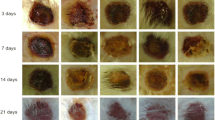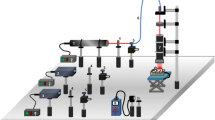Abstract
Recent studies have demonstrated the efficacy of coherent light therapy from the red region of the electromagnetic spectrum on the tissue-healing process. This study analysed the effect of non-coherent light therapy (light-emitting diode—LED) with or without silver sulfadiazine (sulpha) on the healing process of third-degree burns. In this study, 72 rats with third-degree burns were randomly divided into six groups (n = 12): Gr1 (control), Gr2 (non-contact LED), Gr3 (contact LED), Gr4 (sulfadiazine), Gr5 (sulfadiazine + non-contact LED) and Gr6 (sulfadiazine + contact LED). The groups treated with LED therapy received treatment every 48 h (λ = 640 ± 20 nm, 110 mW, 16 J/cm2; 41 s with contact and 680 s without contact). The digital photometric and histomorphometric analyses were conducted after the burn occurred. The combination of sulpha and LED (contact or non-contact) improved the healing of burn wounds. These results demonstrate that the combination of silver sulfadiazine with LED therapy (λ = 640 ± 20 nm, 4 J/cm2, without contact) improves healing of third-degree burn wounds, significantly reduces the lesion area and increases the granulation tissue, increases the number of fibroblasts, promotes collagen synthesis and prevents burn infections by accelerating recovery.




Similar content being viewed by others
References
Martins CBG, Andrade SM (2007) Burns in children and adolescents: hospital morbidity and mortality analysis. Acta Paul Enferm 20(4):464–469. doi:10.1590/S0103-21002007000400013
Rabelo SB, Villaverde AB, Nicolau RA, Salgado MC, Melo MS, Pacheco MT (2006) Comparison between wound healing in induced diabetic and nondiabetic rats after low-level laser therapy. Photomed Laser Surg 24:474–479. doi:10.1089/pho.2006.24.474
Dall-Agnol MA, Nicolau RA, Lima CJ, Munin E (2009) Comparative analysis of coherent light action (laser) versus non-coherent light (light-emitting diode) for tissue repair in diabetic rats. Lasers Med Sci 2009. doi:10.1007/s10103-009-0648-5
Mello PB, Sampedro RMF, Piccinini AM (2007) Effects of the He–Ne laser and of the application mode on healing burns in rats. Fisioter Pesq 4:6–13
Bispo LB (2007) Light emitting diodes: the wave length and its importance. Rev Dent on line.16, jul/dec, 110-113. http://www.ufsm.br/dentisticaonline. Accessed 01 Jun 2009
Al-Watban FAH, Andres BL (2003) Polychromatic LED therapy in burn healing of non-diabetic and diabetic rats. J Clin Laser Med Surg 21:249–258. doi:10.1089/pho.2006.24.10
Vinck EM, Cagnie BJ, Cornelissen MJ, Declercq HA, Cambier DC (2003) Increased fibroblast proliferation induced by light emitting diode and low power laser irradiation. Lasers Med Sci 18:95–99. doi:10.1007/s10103-003-0262-x
Whelan HT, Buchmann EV, Dhokalia A, Kane MP, Whelan NT, Wong-Riley MTT, Eells JT, Gould LJ, Hammamieh R, Das R, Jett M (2003) Effect of NASA light-emitting diode irradiation on molecular changes for wound healing in diabetic mice. J Clin Laser Med Surg 21:67–74. doi:10.1089/104454703765035484
Al-Watban FA, Andres BL (2006) Polychromatic LED in oval full-thickness wound healing in non-diabetic and diabetic rats. Photomed Laser Surg 24(1):10–16. doi:10.1089/pho.2006.24.10
Byrnes KR, Barna L, Chenault VM, Waynant RW, Ilev IK, Longo L, Miracco C, Johnson B, Anders JJ (2004) Photobiomodulation improves cutaneous wound healing in an animal model of type II diabetes. Photomed Laser Surg 22:281–290. doi:10.1089/pho.2004.22.281
Al-Watban FAH, Delgado GD (2005) Burn healing with a diode laser: 670 nm at different doses as compared to a placebo group. Photomed Laser Surg 23:245–250. doi:10.1089/pho.2005.23.245
Gál P, Vidinsky B, Toporcer T, Mokry M, Mozes S, Longauer F, Sabo J (2006) Histological assessment of the effect of laser irradiation on skin wound healing in rats. Photomed Laser Surg 24:480–488. doi:10.1089/pho.2006.24.480
Al-Watban FA, Zhang XY, Andres BL, Al-Anize A (2009) Visible lasers were better than invisible lasers in accelerating burn healing on diabetic rats. Photomed Laser Surg 27(2):269–272. doi:10.1089/pho.2008.2310
Al-Watban FA (2009) Laser therapy converts diabetic wound healing to normal healing. Photomed Laser Surg 27(1):127–135. doi:10.1089/pho.2008.2406
Al-Watban FA, Zhang XY, Andres BL (2007) Low-level laser therapy enhances wound healing in diabetic rats: a comparison of different lasers. Photomed Laser Surg 25(2):72–77. doi:10.1089/pho.2006.1094
Meirelles GCS, Santos JN, Chagas PO, Moura AP, Pinheiro ALB (2008) Effectiveness of laser photobiomodulation as 660 or 780 nm on the repair of third-degree burns in diabetic rats. Photomed Laser Surg 26(1):47–54. doi:10.1089/pho.2007.2051
Oliveira PC, Meireles GCS, dos Santos NR, de Carvalho CM, de Souza APC, dos Santos JN, Pinheiro ALB (2008) The use of light photobiomodulation on the treatment of second-degree burns: a histological study of a rodent model. Photomed Laser Surg 26(4):289–299. doi:10.1089/pho.2007.2148
Ribeiro MS, da Silva DdFT, de Araújo CEN, De Oliveira SF, Pelegrini CMR, Zorn TMT, Zezell DM (2004) Effects of low-intensity polarised visible laser radiation on skin burns: a light microscopy study. J Clin Laser Med Surg 22(1):59–66. doi:10.1089/104454704773660994
Vashegani MMV, Bayat M, Rezaei F, Bayat A, Karimipour M (2008) Effect of low-level laser therapy on mast cells in second-degree burns in rats. Photomed Laser Surg 26(1):1–5. doi:10.1089/pho.2007.2103
Erdle BJ, Brouxhon S, Kaplan M, Vanbuskirk J, Pentland AP (2008) Effects of continuous-wave (670 nm) red light on wound healing. Dermatol Surg 34:320–325. doi:10.1111/j.1524-4725.2007.34065.x
Schlager A, Oehler K, Huebner KU, Schmuth M, Spoetl L (1999) Healing of burns treatment with 670-nm low power laser light. Plast Reconstr Surg 105(5):1635–1639. doi:10.1097/00006534-200004050-00006
Schlager A, Kronberger P, Petschke F, Ulmer H (2000) Low-power laser light in the healing of burns: a comparison between two different wavelengths (635 and 690 nm) and a placebo group. Lasers Surg Med 27:39–42. doi:10.1002/1096–9101(2000)27:1<39::AID-LSM5>3.0.CO;2–4
Yu W, Naim JO, Lanzafame RJ (1997) Effects of photo-stimulation on wound healing in diabetic mice. Lasers Surg Med 20:56–63. doi:10.1002/(SICI)1096–9101(1997)20:1<56::AID-LSM9>3.0.CO;2-Y
Corazza AV, Jorge J, Kurachi C, Bagnato VA (2007) Photobiomodulation on the angiogenesis of skin wounds in rats using different light sources. Photomed Laser Surg 25(2):102–106. doi:10.1089/pho.2006.2011
Gonçalves WLS, Souza FM, Conti CL, Cirqueira JP, Rocha WA, Pires JGP, Barros LAP, Moysés MR (2007) Influence of He–Ne laser therapy on the dynamics of wound healing in mice treated with anti-inflammatory drugs. Braz J Med Biol Res 40:877–884. doi:10.1590/S0100-879X2007000600018
Reis SRA, Medrado AP, Marchionni AMT, Figueira C, Fracassi LD, Knop LAH (2008) Effect of 670-nm laser therapy and dexamethasone on tissue repair: a histological and ultrastructural study. Photomed Laser Surg 26(4):307–313. doi:10.1089/pho.2007.2151
Gál P, Mokrý M, Vidinský B, Kilík R, Depta F, Harakaľová M, Longauer F, Mozeš S, Sabo J (2009) Effect of equal daily doses achieved by different power densities of low-level laser therapy at 635 nm on open skin wound healing in normal and corticosteroid-treated rats. Lasers Med Sci 24:539–547. doi:10.1007/s10103-008-0604-9
Sommer AP (2007) Antiinfectives and low-level light: a new chapter in photomedicine. Photomed Laser Surg 25(3):150–158. doi:10.1089/pho.2007.2058
Pugliese LS, Medrado AP, Reis SRA, Andrade ZA (2003) The influence of low-level laser therapy on biomodulation of collagen and elastic fibres. Pesq Odont Bras 17(4):307–313. doi:10.1590/S1517-74912003000400003
Meirelles GCS, Santos JN, Chagas PO, Moura AP, Pinheiro ALB (2008) A comparative study of the effects of laser photobiomodulation on the healing of third-degree burns-a histological study in rats. Photomed Laser Surg 26(2):159–166. doi:10.1089/pho.2007.2052
Busnardo VL, Biondo-Simões MLP (2010) Effects of low-level helium–neon laser on induced wound healing in rats. Rev Bras Fisiot 14(1):45–51. doi:10.1590/S1413-35552010000100008
Enwemeka CS, Parker JC, Dowdy DS, Harkness EE, Sanford LE, Woodruff LD (2004) The efficacy of low-power lasers in tissue repair and pain control: a meta-analysis study. Photomed Laser Surg 22:323–329. doi:10.1089/pho.2004.22.323
Houreld N, Abrahamse H (2007) In vitro exposure of wounded diabetic fibroblast cells to a helium–neon laser at 5 and 16 J/cm2. Photomed Laser Surg 20(2):78–84. doi:10.1089/pho.2006.990
Houreld N, Abrahamse H (2008) Laser light influences cellular viability and proliferation in diabetic-wounded fibroblast cells in a dose- and wavelength-dependent manner. Lasers Med Sci 23:11–18. doi:10.1007/s10103-007-0445-y
Hawkins D, Abrahamse H (2005) Biological effects of helium–neon laser irradiation on normal and wounded human skin fibroblasts. Photomed Laser Surg 23(3):251–259. doi:10.1089/pho.2005.23.251
Hawkins D, Abrahamse H (2006) Effect of multiple exposures of low-level laser therapy on the cellular responses of wounded human skin fibroblasts. Photomed Laser Surg 24(6):705–714. doi:10.1089/pho.2006.24.705
Minatel DG, Franca SC, Enwemera CS, Frade MAC (2009) Phototherapy (LEDs 660/890nm) in the treatment of leg ulcers in diabetic patients: case study. An Bras Dermatol 84(3):279–283. doi:10.1590/S0365-05962009000300011
Almeida-Lopes L, Rigau J, Jaeger MMM, Brugnera AJr, Vélez-González M (1998) Acción del láser a baja densidad de potencia en la proliferación in vitro de fibroblastos de encía humana. Bol SELMQ 14(5):14–18
El Sayed SO, Dyson M (1990) Comparison of the effect of multiwavelength light produced by a cluster of semiconductor diodes and each individual diode on Mast cell number and degranulation in intact and injured skin. Lasers Surg Med 10:559–568. doi:10.1002/lsm.1900100608
Piva JAAC, Abreu EMC, Silva VS, Nicolau RA (2011) Effect of low-level laser therapy on the initial stages of tissue repair: basic principles. An Bras Dermatol 86(5):947–954. doi:10.1590/S0365-05962011000500013
Acknowledgments
R. A. Nicolau thanks the National Council for Scientific and Technological Development (CNPq, Brazil) for the productivity fellowship (process no. 314455/2009-4).
Author information
Authors and Affiliations
Corresponding author
Rights and permissions
About this article
Cite this article
Neves, S.M.V., Nicolau, R.A., Filho, A.L.M.M. et al. Digital photogrammetry and histomorphometric assessment of the effect of non-coherent light (light-emitting diode) therapy (λ640 ± 20 nm) on the repair of third-degree burns in rats. Lasers Med Sci 29, 203–212 (2014). https://doi.org/10.1007/s10103-013-1312-7
Received:
Accepted:
Published:
Issue Date:
DOI: https://doi.org/10.1007/s10103-013-1312-7




